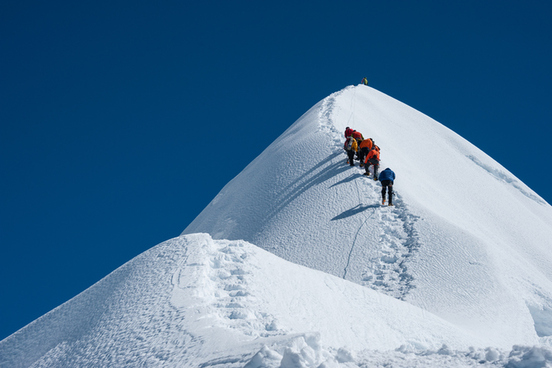
Névé
Definition: the partially compacted granular snow that forms the surface part of the upper end of a glacier; broadly : a field of granular snow
Névé is indeed snow, although it is of a more particular kind than just “cold white stuff” (and it is also occasionally called firn). The word comes from a word in the Swiss dialect of French, and, prior to that, comes from the Latin word for snow (nix). Our language has used this Latin root to form a large number of words for snow-related things, although most of them are quite obscure. We have niveous (“resembling snow”), subnivean (“situated or occurring under the snow”), and ninguid (defined by Thomas Blount in 1656 as “where much Snow is”).
The distinction between névé and true glacier ice is plainly manifest in the Sierra Nevada glaciers, not only when viewing them from a distance, but also while traversing their surfaces.
—Israel Cook Russell, Existing Glaciers of the United States, 1885
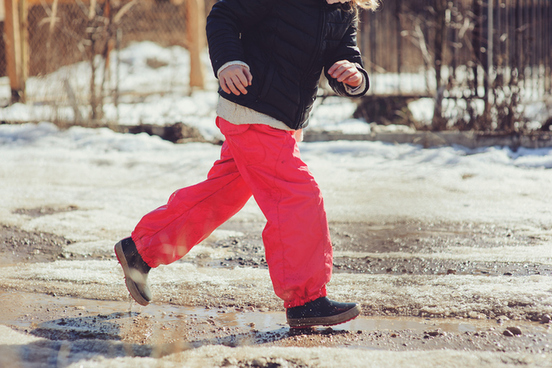
Sposh
Definition: soft slushy mud or snow
Sposh is thought to be a combination of the words slush and posh, but before you get overly excited about the new factoid with which you plan on boring your in-laws to tears, there are a couple of things you should know. First, posh does not itself come from "port-outward-starboard-home," or any other acronym. Second, the posh that sposh is based on is a totally different kind of than the one meaning "fashionable"; this one is an archaic word, meaning “a slushy mass (as of mud or broken ice).”
I enjoy not less what may be called the negative side of spring, — those dark dank, dissolving days, yellow sposh and mud and water everywhere, — yet who can stay long indoors?
—John Burroughs, Birds and Poets, 1895

Blizzard
Definition: a long severe snowstorm
Every time there is a blizzard, or even the chance that a blizzard might stop by for a visit, the event will be accompanied by a host of people who will insist on informing you that in order for it to really be a blizzard there must be at least three hours of snow with winds reaching 35 MPH, and visibility of a quarter mile or less.
By Friday night, an “all-out blizzard” is anticipated from central and northeastern South Dakota to central and eastern North Dakota, according to AccuWeather meteorologist Bernie Rayno. Unnecessary travel should be avoided in these areas.
— Doyle Rice, USA Today, 11 Oct. 2019
These conditions are necessary before the National Weather Service in the United States will call something a blizzard; however, for the rest of us, a somewhat less strict definition applies. Blizzard may be applied to such events as “a long severe snowstorm,” “an intensely strong cold wind filled with fine snow,” or figurative uses such as “an overwhelming rush.”
i am dying in lala in a blizzard of sun where
my killers always profit from my death.
—Wanda Coleman, Bathwater Wine, 1998
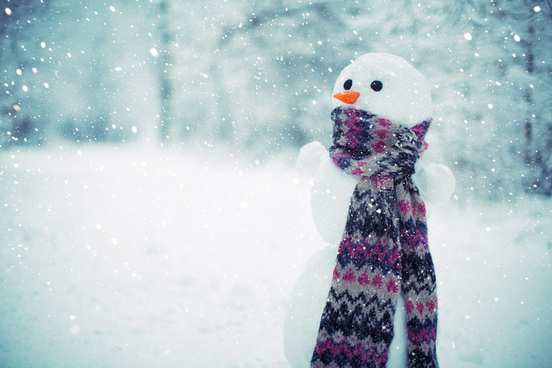
Onding
Definition: a heavy fall of rain or snow
Suppose there’s been a heavy snowfall, but it has not met the strict criteria necessary to be called a blizzard by the National Weather Service, and suppose you are the sort of person who cares about such things…well, what do you call that snowfall (other than inconvenient)? You may call it an onding, a lovely regionalism that has been in use in Scotland and Northern England since the middle of the 18th century.
”Look out, Jock; what night is’t?” “Onding o’ snaw, father,” answered Jock, after having opened the window, and looked out with great composure.
—Walter Scott, The Heart of Mid-Lothian, 1818
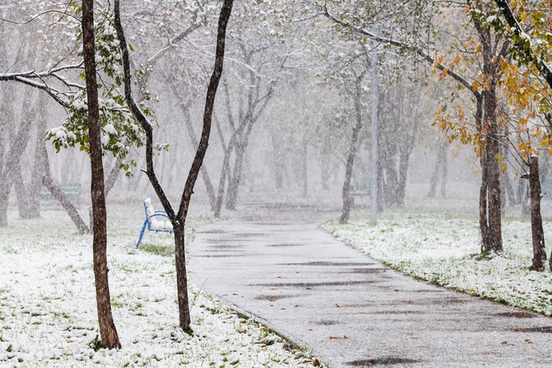
Skift
Definition: a light fall of snow or rain
Tho there’s not enough snow for a drift,
Just enough has fell that you’re miffed;
Your boss makes you work
(why, the nerve of that jerk)
As he says that it’s naught but a skift.
We had a skift of snow (a sight never before witnessed here at this season of the year), on the night of the 21st. The bees were housed for 3 days.
—G. W. Demaree, (letter) The American Bee Journal, 6 Jun. 1883“We don’t typically plow the entire city just when we get a little skift of snow,” Heintz said. “Two inches or so, we’ll get into those emergency routes, but it needs to get up to about 3.5, 4 inches or a 4-inch accumulation over a number of days before we even consider going into residential.”
— Cheryl McCormack, The Bismarck Tribune, 27 Feb. 2019

Graupel
Definition: granular snow pellets
Graupel, which is sometimes also referred to as soft hail, comes to English from German, in which language it is the diminutive of the word for “pearl barley” (Graupe). The word appears to have begun being used in the 1870s, when meteorologists of that time decided that there was a need to distinguish between different kinds of hail.
He refers to our comparative ignorance of the origin and peculiarities of the appearance of hail, of the want of long series of observations on the subject, and in those that do exist of the frequent confounding of hail and graupel—the balls of true hail having an icy structure, whereas the balls of graupel are only small pellets of snow.
—Nature, 2 Nov. 1876
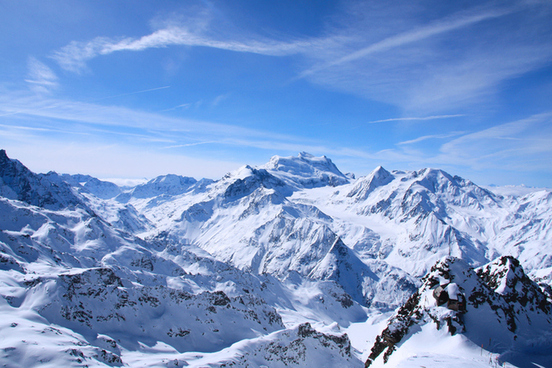
Firnification
Definition: the process whereby snow is changed to névé
Many of the words relating to snow in the English language are short little things, which has doubtless caused some of you to wonder when the fancy words will arrive. Well, firnification is the two dollar word you’ve been looking for. It may be several years before you have an opportunity to use it in the correct context, but just imagine how happy you will be when you find yourself standing on the upper end of a glacier while the snow is actively turning to névé.
In any alpine winter snowscape it seems as though Nature has stood still under its winter mantle, and that all is peace. Yet, in truth, the snow cover is a vast and active laboratory in which the flakes are made to undergo incessant and increasing change, until the time when they disappear in spring and commence their long journey to the sea, or, at high altitudes, become converted into glacier ice. These changes are called ‘firnification.’
—Gerald Seligman, Nature, 26 Jun. 1937
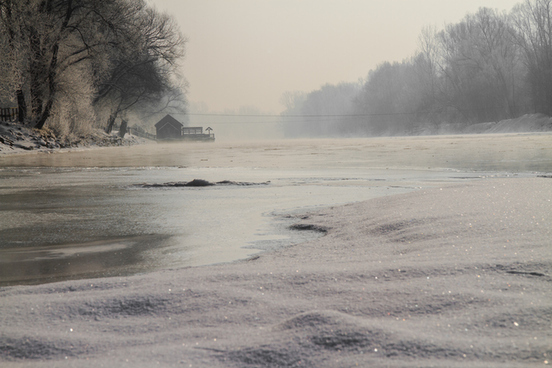
Grue
Definition: thin floating ice: snow
There are several meanings of grue, and the obscurity of each makes one wonder how such a pleasant and useful term should have fallen by the linguistic wayside. In addition to having the definition above, grue may function as a verb, meaning “to shiver or shudder, especially with fear or cold,” and with a number of additional noun senses, including “a fit of shivering” and “gruesome quality or effect.”
Thro' driftin' snaw, an' blashie sleet,
Puir bodies wade, an' grue, an' grane;
Then comes the white-pow'd warlock frost,
An' a' he touches turns to stane.
—Janet Hamilton, Poems of Purpose, 1865

Corn snow
Definition: granular snow formed by alternate thawing and freezing
Corn snow is also referred to as spring snow, and occasionally simply as corn. It is one of the more recent additions to our vocabulary of snow types, beginning to be used (mainly in describing ski conditions) in the early 20th century.
It seems that on the high peaks of the Island of Hawaii, for several months during the year, there is “corn snow.” “Corn snow” is the finest there is for skiers. It is dry and crunchy. At least, so says Mr. Larson.
—Ed Ainsworth, The Los Angeles Times, 6 Sept. 1937

Sleet
Definition: frozen or partly frozen rain
Sleet is basically the ambivert of weather systems. Go on ... you know you want to go look up what ambivert is.
But now, dear love, is the summer's reign,
And the thistles wound our feet;
We seek escape from their thorns in vain,
And climb the hillside with toil and pain,
Yet knowing and saying again and again
That thistles are kinder than sleet, beloved,
Thistles are kinder than sleet!
—Elizabeth Akers Allen, Poems, 1868





